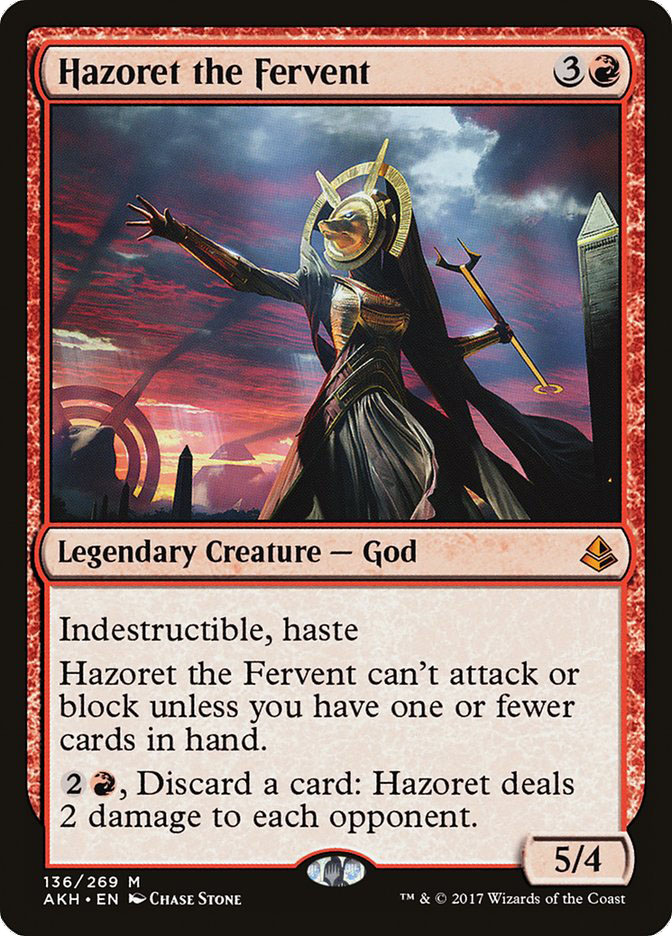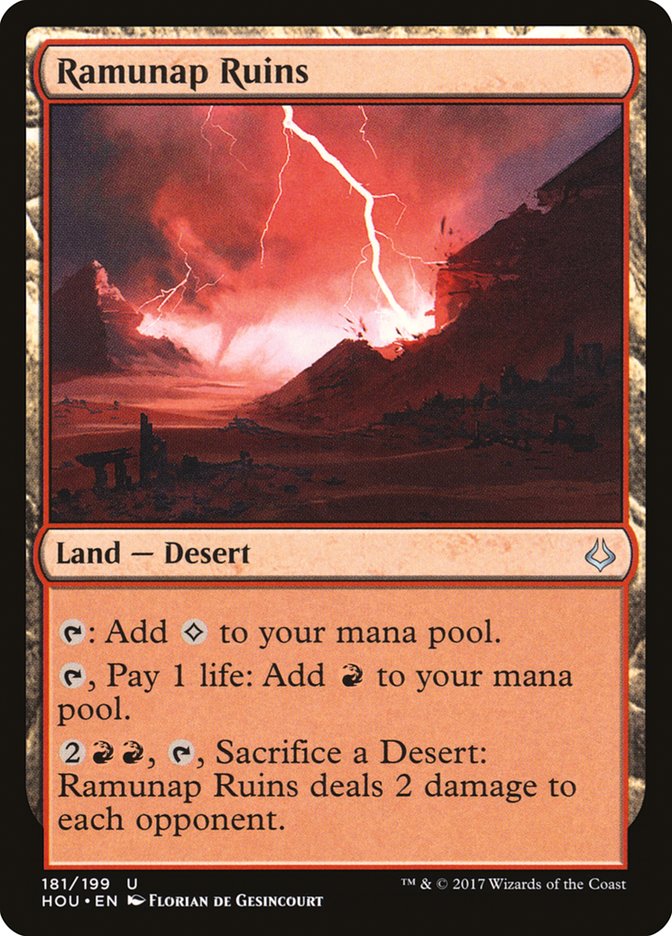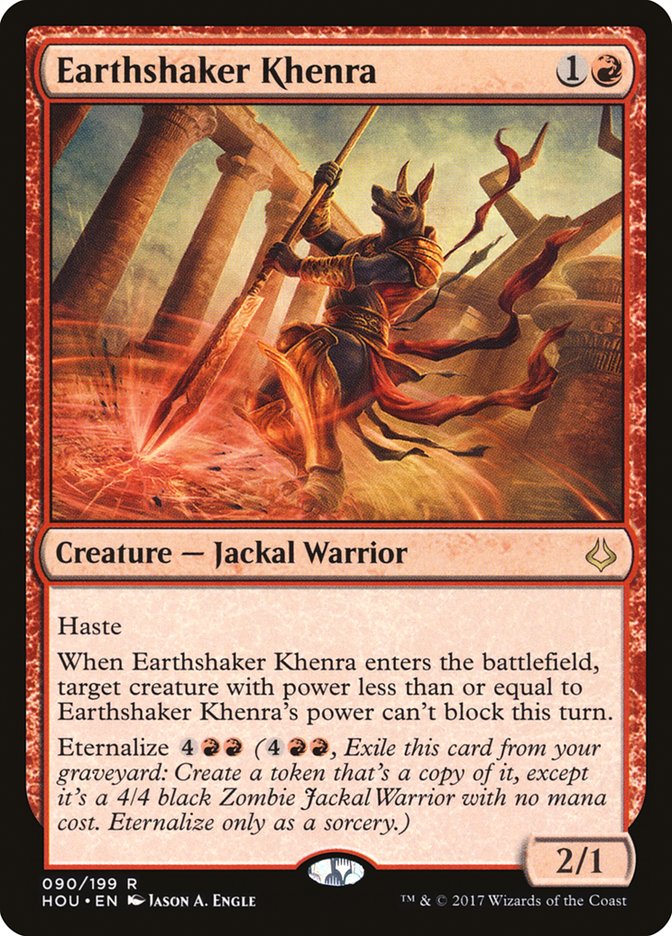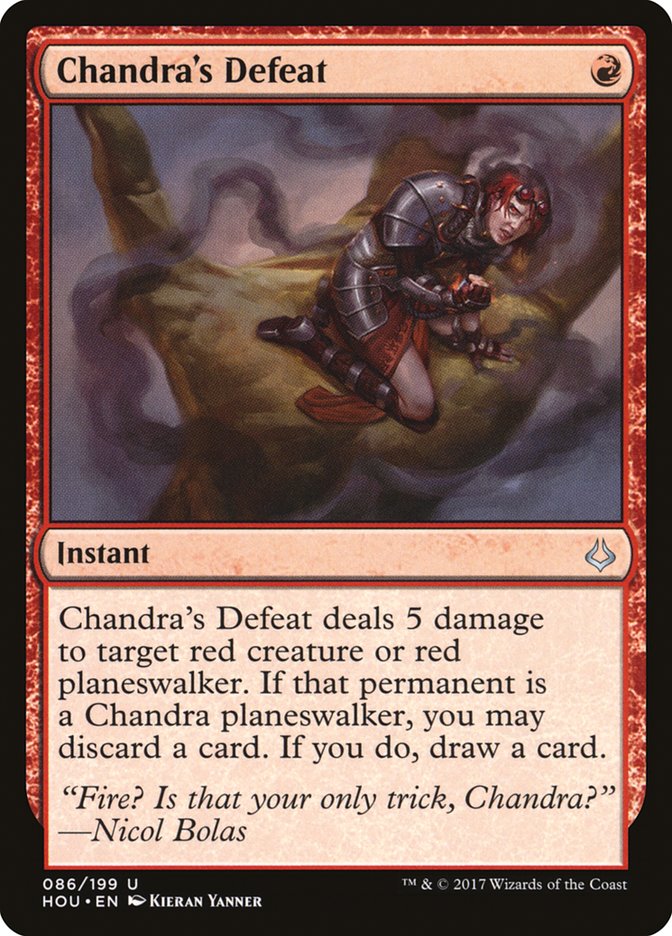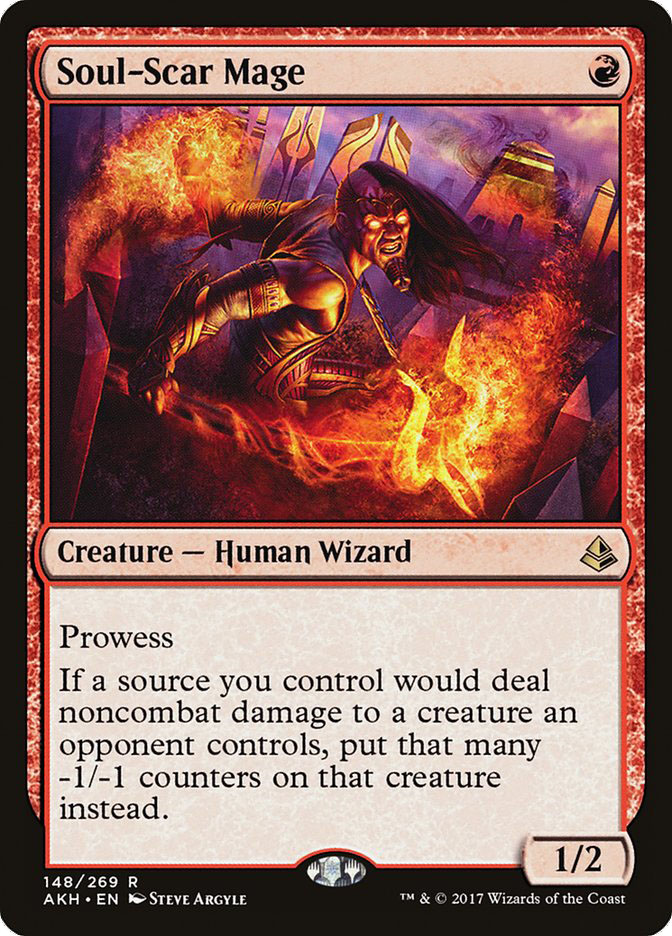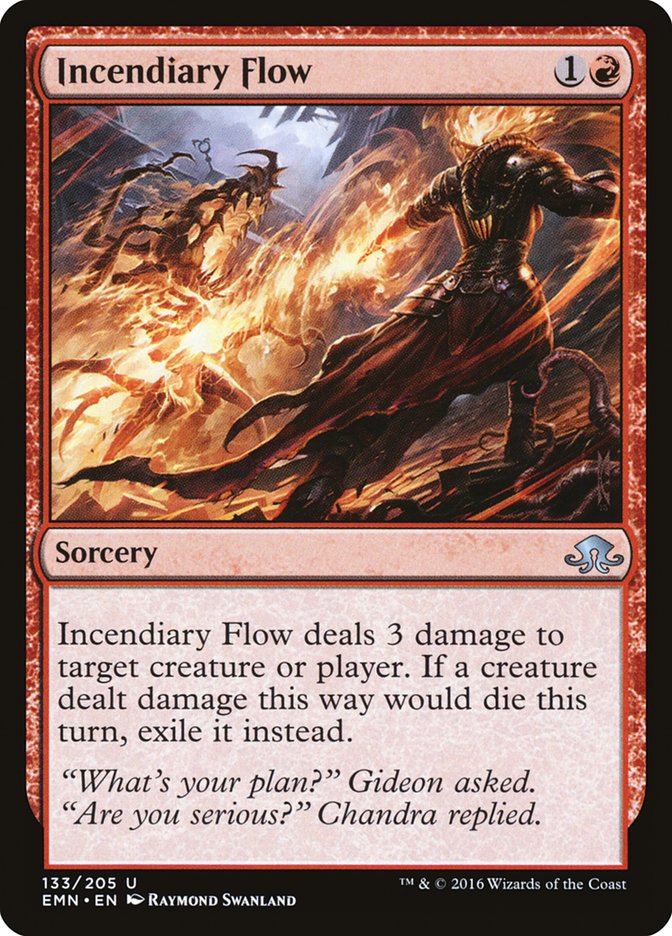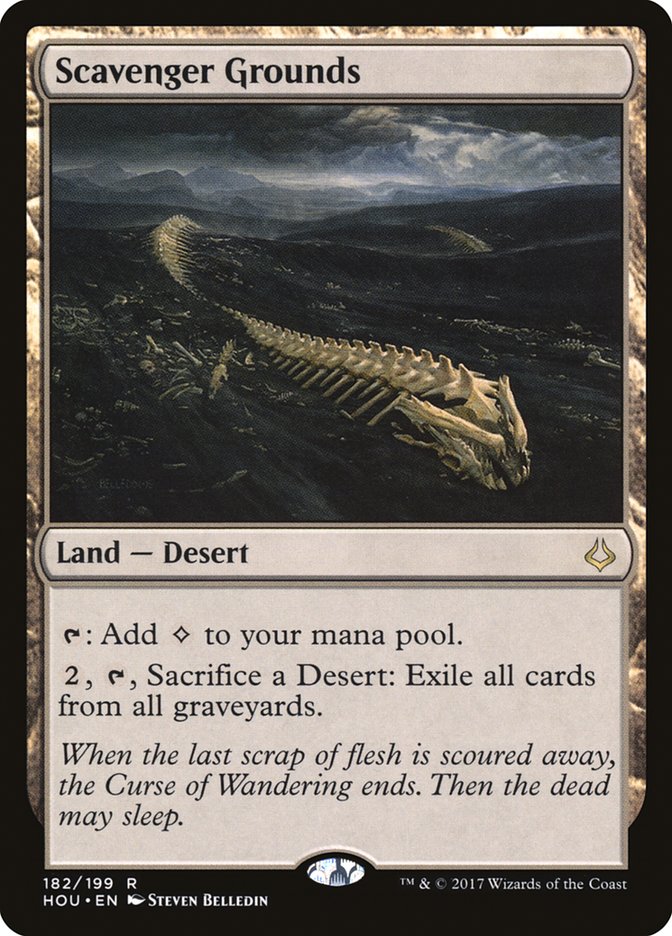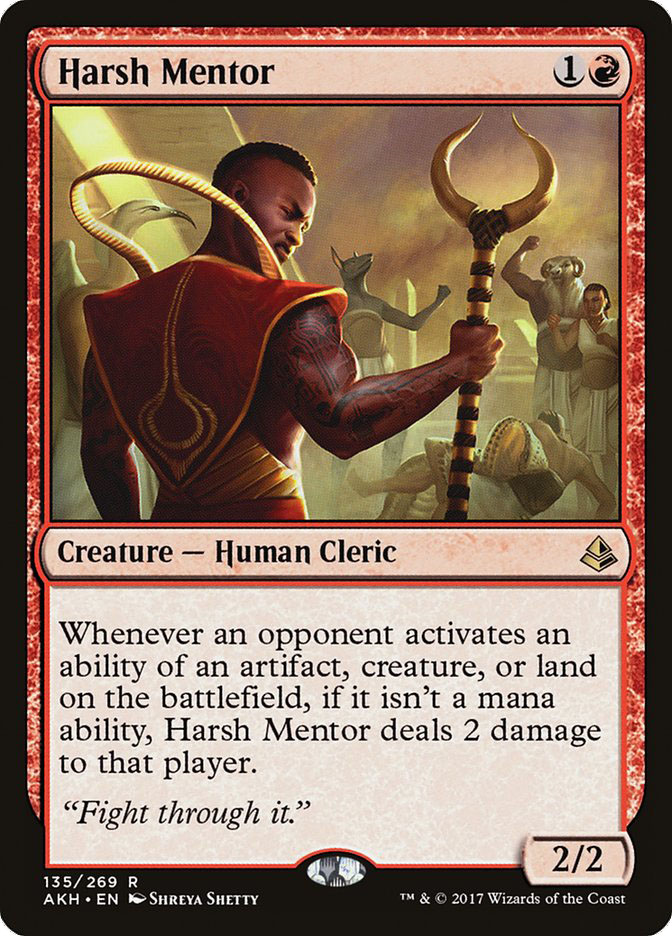The story of Pro Tour Hour of Devastation was all about Ramunap Red and the decks people thought could beat it. Had I not been busy on Thursday trying to convince Sam Black to play the deck, I would have written an article predicting that narrative. There was also the matter of trying to figure out what to play myself, which Sam eventually helped with.
The Plan
When looking at how the decks in Standard matched up against each other, it was clear that Ramunap Red was the best deck. The questions to ask: what beats it, and how will people react to its presence?
One of the ways to fight mono-red decks in general is by doing things that end up being good against the deck on their own, such as making tokens, assembling a large Walking Ballista, or attacking them with Hazoret the Fervent.
Very few decks in the format actually match up well against Ramunap Red because of how secretly resilient it is. Blockers tend to be a non-issue because of removal and things like Ahn-Crop Crasher. With the majority of their creatures having haste, even spot removal can be lackluster at times.
A gross misunderstanding of Ramunap Red led to me playing zero games with the deck, as I felt I already had a clear understanding of what the deck was trying to do after playing against it a bunch. While that was true, that also meant I didn’t try to improve the deck at all, which is what everyone did, and that led to Ramunap Red functioning much differently.
We knew a mono-red deck with Hazoret the Fervent was the best deck, and we knew what we wanted to do in each matchup post-sideboard, but we didn’t get around to cutting the low-impact cards from the maindeck. Obviously that problem could have been averted with a better testing process, and that’s certainly something to learn from in the future.
If a deck is killing it and still has room to be refined, you should pay attention and probably do the work yourself. I failed to realize that early enough this time, mostly due to assuming the red decks were stuck being linear.
Why Ramunap Red Is Good
Depending on their list, they can be a true “face” deck, where all of the damage past turn 4 or so is directed at the opposing player; a battlefield-control-centric list; or a mix of the two where you end up having a lot of reach but are mostly focused on stopping them from getting traction. The latter is more powerful, given its less linear nature, and that’s exactly where I want to be, especially once people are trying to fight the linear nature of the other red decks.
Ramunap Ruins and Earthshaker Khenra are effectively your expensive cards, which means you can get away with playing a lot of lands while not actually having a top-end to your curve. It’s very rare that the deck runs out of things to do with its mana. Post-sideboard, you can bring in powerful cards to take advantage of your high land count without having to wasting to precious sideboard slots on more mana sources. That allows you to juke your opponent’s sideboard cards that are aiming to defeat your smaller creatures.
That, in addition to its excellent removal, resilient threats, and random free wins from things like Bomat Courier, makes Rampunap Red a threat, even when everyone knows about it.
Why Our List Was Bad
Creatures (26)
- 4 Falkenrath Gorger
- 4 Village Messenger
- 4 Bomat Courier
- 3 Kari Zev, Skyship Raider
- 3 Hazoret the Fervent
- 4 Ahn-Crop Crasher
- 4 Earthshaker Khenra
Lands (21)
Spells (13)

(The only difference between what I registered was a Mountain over the sideboarded Hanweir Battlements, which may have cost Sam a game in the Top 4.)
As noted, I spent most of Thursday trying to convince Sam Black to play it, so we didn’t have much time to actually fine-tune the list. It’s easy enough to eyeball a list and get the gist of what a deck is doing. In some instances, you have to actually play games. In this case, we learned a lot from the first few games we played. For example, the list we started with appeared to be doing all it could to topdeck a lethal combination of cards.
Cartouche of Zeal didn’t seem great in the majority of games we saw, but it allowed you turn some of your non-lethal topdecks into lethal ones. It also punished those who played carelessly when they were mostly stabilized. Despite that, it was probably a card we would side out most of the time in favor of a more solid, midrange plan.
We missed a few things. For starters, Village Messenger is pretty bad. Similarly, Cartouche of Zeal is also pretty bad.
You can build a mono-red deck in a variety of ways, like the all-in lists from Magic Online, the burn-based lists with Collective Defiance, or the battlefield-control-centric list from Paulo Vitor Damo Da Rosa. After playing in the Pro Tour, it’s easy to see the all-in lists do not match up well against opponents with resistance.
Given how little the both of us had played the deck, the question of “Should we fundamentally alter how this deck functions?” never really came up. We decided to play a hyper-aggressive deck and be fine with that.
We wanted extra interaction and burn for bigger creatures, as those seemed like the easiest way to beat us, but we never took that extra step into Chandra, Torch of Defiance territory. Collective Defiance made the cut and seemed a little clunky, but necessary, given how Zombies was starting to maindeck Kalitas, Traitor of Ghet.
Ramunap Red didn’t seem to flood all that often, thanks to how often having excess lands ended up being great thanks to Ramunap Ruins and Earthshaker Khenra, so going a little bigger in Game 1 would have made a lot of sense.
If I could do it all over again, I’d do a lot of things differently.
Updated List
I think Yam Wing Chun’s list was a better version of our list, and I think PVDDR’s list was probably better overall. Honestly, PVDDR’s maindeck is pretty damn good and I wouldn’t change much.
If I were playing Standard this weekend, I would register this:
Creatures (25)
- 4 Falkenrath Gorger
- 4 Bomat Courier
- 3 Kari Zev, Skyship Raider
- 3 Hazoret the Fervent
- 4 Ahn-Crop Crasher
- 3 Soul-Scar Mage
- 4 Earthshaker Khenra
Planeswalkers (2)
Lands (23)
Spells (10)

I’m more than happy with cutting a one-drop. This isn’t old school Extended Zoo where playing three two-drops by turn 2 is super powerful. Just having something to do on turn 1 and fill your curve with later is acceptable.
Once you make the concession that you’re not a burn deck, you can lose the “damage only” Village Messenger and Cartouche of Zeal for some more staying power, such as Soul-Scar Mage. You won’t be triggering prowess as often as you might be used to in decks with Monastery Swiftspear, but the “wither” text is relevant against Hazoret and other larger creatures.
Chandra’s Defeat plus Soul-Scar Mage is basically the only way to take down Hazoret the Fervent in the mirror match. Going forward, it’s entirely possible that more people adopt the Reality Smasher sideboard plan from Genesis, which could make things a little awkward. For now, the best option seems like maximizing Hazoret and the ability to remove theirs.
Four Hazoret the Fervents might be the right call for the maindeck, or at least it could have been for the Pro Tour. However, if the format shifts toward more ways to answer Hazoret in Game 1, like with Zombies and its pile of Grasp of Darknesses and Dark Salvations, then that switch wouldn’t make much sense. I like a hedge until proven otherwise.
The loss of Incendiary Flow is sad, since the direct damage did win me a lot of games, but presumably having sideboard space from moving the Abrades maindeck will win me more. I could see a list with the full amount of Incendiary Flows and Collective Defiances being quite good, especially against how the format could shift against the deck.
Scavenger Grounds was a fine call for the Pro Tour, but with the God-Pharaoh’s Gift decks falling short, it’s not nearly as useful going forward. Dunes of the Dead is another somewhat useful Desert that I could see slotting into the deck instead. Either way, that slot probably won’t decide many games.
Savage Alliance is cute against the Magic Online lists, but it won’t be very impressive going forward. I feel similarly about Aethersphere Harvester. Most decks can lean on that card as a colorless hate card for red decks, but it’s one that falls flat in the face of Abrade and a bigger sideboard plan.
Harsh Mentor is a sideboard card that looked good against the various B/G decks, but I haven’t gotten to try it out yet. I could see it pulling its weight if you stay low to the ground, but with the go-big plan, it’s probably worse than having Cut // Ribbons.
Some players at the Pro Tour included several sideboard cards for the Ramp matchup, but that didn’t seem defensible to me. I didn’t expect the deck to show up en masse, and while 6% is higher than what I expected, it’s not something you should be worried about yet. Warping Wail and the various Threatens (Kari Zev’s Expertise and Eldrazi Obligator) are both good in that matchup, but it’s not exactly necessary.
The ultimate question is how viable the deck is going forward. Magic Online has already started to adapt, but I think it’s been blown out of proportion how easy Ramunap Red is to hate out. If that were the case, we probably would have seen that instead of how lopsided the Top 8 was overall. Obviously there are some other factors, such as six rounds of Draft, but people who thought they were ready for Ramunap Red with their Gifted Aetherborns were sorely mistaken.
One of the worst things for Ramunap Red is everyone else having a much better understanding of how the deck operates. You can’t sideboard to beat X/1 creatures and you shouldn’t necessarily mulligan aggressively for early defense. It’s a complicated, multi-faceted deck, and with that knowledge, people will play better against you as a whole.
Maybe Ramunap Red is simply a good deck instead of by far the best deck, but I’m pretty sure it’s still the best thing you can be doing.
Sideboarding Guide
Ramunap Red (The Mirror)
In:
Out:
You have to respect the possibility of early aggression, so things like Pia Nalaar are useful even if everyone is on the “go big” plan.
Zombies
In:
Out:
They have too much removal that cleanly answers Hazoret the Fervent for you to keep it in. Similarly, they have too much removal for something like Ahn-Crop Crasher. While Crasher doesn’t answer a Liliana, the Last Hope cleanly with a Sunscorched Desert, a three mana 3/2 isn’t exactly going to carry you in the matchup. There are similar issues with Soul-Scar Mage.
U/R Control
In:
Out:
If the game goes long, you have inevitability with your lands. That leads me to believe you should keep in some number of Abrades for their Torrential Gearhulks, since it’s their only reliable way to clock you. It can also take out a Whirler Virtuoso that they should start sideboarding against you. Finishing off a Thing in the Ice once they block is also reasonable.
In some games, your plan is to force a Sweltering Suns or Hour of Devastation so you can resolve a powerful four-drop.
B/G Constrictor
In:
Out:
You basically just want a bunch of stuff that deals four damage in this matchup. Kalitas, Traitor of Ghet is the obvious threat, but a Grim Flayer with delirium and various planeswalkers are also relevant.
Hazoret the Fervent is still reasonable in the face of Grasp of Darkness here. They have very few removal spells to kill it, and you might be able to force them to Grasp something else first. Overloading on big cards in a concern, but the matchup is basically defined by who can stick one of their powerful threats first. Going long, their gameplan will mostly overwhelm yours.
Temur Energy
In:
Out:
Sideboarding is light here, although it could be more intense. If they have Glorybringer, Chandra, and Whirler Virtuoso in after sideboarding, you could bring in more Chandra’s Defeats. Your own Chandras and Glorybringers are just fine, but nothing spectacular. Chandra, Torch of Defiance tends to lose to their Glorybringers.
They are going to have to do some weird things to beat a resolved Hazoret, like blocking with Thopters, Bristling Hydra, or Rhonas the Indomitable. Control Magics like Kefnet’s Last Word and Confiscation Coup are reasonable. Aether Meltdown isn’t great. They could just try to race you with Arborback Stompers and Life Goes On.
Keep your Abrades for potential Aethersphere Harvesters.
***
This is the first time I’ve played a red aggro deck at a Pro Tour and been actively pleased with my choice. In fact, details aside, I’ve been rather proud of my Standard deck selection as of late. The work I’m putting in is clearly paying dividends, and having great teammates always helps too!


